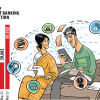The future of retail banking

Retail banking in Bangladesh is entering a moment of reckoning. With the Bangladesh Bank (BB) preparing to issue digital banking licences, and with more organised mobile financial services, AI and platform technology becoming mainstream, it is no longer enough for a bank to be a place where people open an account, deposit money or apply for a loan. That model was built for a time when banking was scarce, branches were the primary touchpoint, and margins were wide. Today, customers have options and expectations that move faster than branch infrastructure. The question is not whether digital banks will replace traditional ones, but whether traditional banks will use this moment to evolve.
Digital banks will no doubt attract the younger, mobile-first population. That will be a catalyst, not a takeover. The real pressure will fall on legacy retail banks that still run large brick-and-mortar networks with high operating costs and thin spreads. Maintaining branches only to complete routine transactions is becoming difficult to justify. Instead of hundreds of transactional counters, banks can turn branches into advisory hubs, experience zones and acquisition centres for higher value products such as wealth, SME, housing and cross-border services. The branch can become the place where trust is built and complex products are explained, while day-to-day services are completed on apps and ATMs.
Globally, banks that are growing retail income are not relying only on interest. They are adding fee-based and lifestyle-linked services inside the same ecosystem. Bangladesh can do the same. A bank app should not stop at balance inquiry. It can help customers buy insurance, invest in a small portfolio, pay for travel, track tax obligations or even access curated property listings. This is how a bank moves from transactional to transformational and keeps the growing middle class and affluent customers inside its own environment rather than losing them to foreign platforms or informal agents.
To get there, technology modernisation is not a side project. It is the foundation. Cloud-ready cores, open APIs and AI-powered analytics give a bank the ability to personalise offers, score risk faster, integrate fintech partners and lower the cost to serve. Without this, retail transformation will remain a PowerPoint idea. With it, banks can serve the mass market digitally and reserve physical spaces for higher-value engagement.
Regulation will need to move in parallel. Some asset and investment products are still underused because of ambiguity. A sandbox and clearer guidelines can unlock new services while keeping consumer protection intact. The biggest risk for banks now is not digital competition, it is inertia. The winners will be the ones that keep the trust and balance sheet strength of a bank, but redesign the retail experience for a customer who lives on a screen, not in a queue.
This shift is not new. When JPMorgan leaders said almost a decade ago that they were a technology company that happened to provide banking, they were not making a marketing statement; they were describing the direction of the business. They were saying that the infrastructure, data and software layer would create the value, and banking products would be the services on top. Capital One and DBS Bank in Singapore also moved in the same direction.
Bangladeshi banks are now at the same crossroads. If they keep thinking like branch networks, digital banks and MFS players will capture the customer relationship. If they start thinking like technology companies that deliver regulated financial services, branches can be repurposed into high-value experience hubs, and the bank stays at the centre of the customer's financial life. Banks can also optimise their costs by shifting branches from posh avenues to customer-friendly locations. They need to cover more gaps in individual client lives and build solutions for evolving needs, from healthcare to capital gains.
The writer is an economic analyst and chairman at Financial Excellence Ltd

 For all latest news, follow The Daily Star's Google News channel.
For all latest news, follow The Daily Star's Google News channel. 








Comments